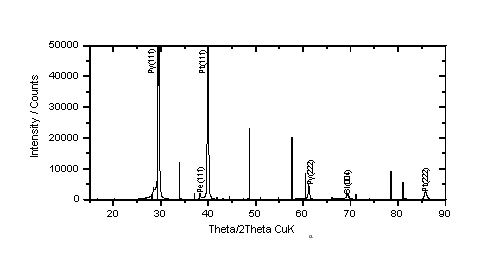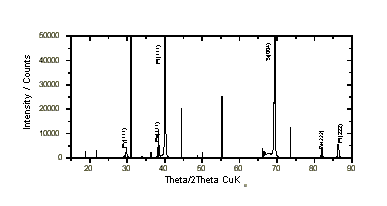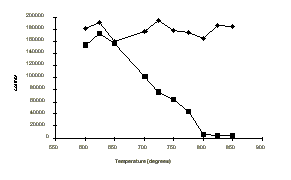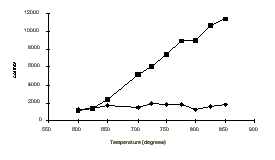
THE APPLICATION OF X-RAY DIFFRACTION TO TEXTURED POLYCRYSTALLINE THIN FILMS: LEAD SCANDIUM TANTALATE DEPOSITED ON PLATINISED SILICON SUBSTRATES.
P.P. Donohue, J.C. Jones, M.A.C. Harper and M.A. Todd.
Defence Evaluation and Research Agency, St. Andrews Road, Malvern, Worcestershire, WR14 3PS, United Kingdom
Key Words: thin films, Lead Scandium Tantalate, pyrochlore, perovskite, phase transformation.
Thin films of lead scandium tantalate (PST) are being investigated for use as the sensing medium in integrated uncooled thermal detectors [1,2]. In this study thin films of PST have been deposited on platinised silicon substrates by RF magnetron sputtering. The deposition involved the use of dual targets, substrate oscillation and rotation to produce a stoichiometrically and crystallographically uniform thin film over a 3" substrate. The layer structure of the thin films were as follows: Si(100)/SiO2/Ti/Pt/PST and the layer thicknesses 400mm/0.8mm/75Ä/1000Ä/1mm. The deposition was performed at low temperatures compatible with standard silicon foundry processing. Samples were analysed using a Siemens D5000 X-ray diffractometer with a filtered Cu-K source in step-scanning mode. The X-Ray diffraction patterns show that the dominant PST phase in the as deposited thin films is pyrochlore, figure (1), and that the samples are highly (111) textured. PST has two forms, the non-ferroelectric pyrochlore phase and the relaxor ferroelectric perovskite phase [3]. The latter phase is of interest for use in dielectric bolometer mode uncooled thermal detectors.

Figure 1: X-ray diffraction pattern of as deposited PST thin film with the JCPDS (45-554) pattern of pyrochlore
Post deposition rapid thermal annealing (RTA) in flowing oxygen has been performed between 600oC and 850oC. Analysis of the samples using X-ray diffraction has shown a progressive transformation, with increasing steady state RTA temperature, of the pyrochlore phase to the perovskite phase, figures (2) - (4). The samples have been found to transform from a highly (111) textured pyrochlore phase to a highly (111) textured perovskite phase. The highly textured nature of the PST grains, both as deposited and after RTA, is thought to be influenced by the exclusively (111) orientated Pt substrate which was deposited by RF magnetron sputtering. These results contrast sharply with depositions onto sacrificial layers [4] where the Pt was mixed phase and this resulted in a preferred PST (110) orientation. The results do not show ordering of scandium and tantalum onto the perovskite B sites as has been observed in high temperature furnace annealing [1].
Results will also be discussed in terms of the deconvolution
of the PST perovskite (111) peak and the Pt (111) peak.
Furthermore the use of grazing incidence X-ray diffraction to
indicate the perovskite/pyrochlore distribution within the PST
layer will also be presented in the paper.
1. R. Watton and M.A Todd, Ferroelectrics,
1991, Vol. 118, pp 279-295.
2. R. Watton et al, SPIE Vol. 2744, IR Tech and Appl., XXII,
Orlando 96.
3. N. Setter and L.E. Cross, J. Appl. Phys., 51 (8),
August 1980.
4. Z. Huang et al, J. Mat. Sci., 33, 1998, 363-370.

Figure 2: X-ray diffraction
pattern of RTA PST thin film at 850oC
with the JCPDS (43-134) pattern of perovskite.

Figure (3) PST Pyrochlore
(111) counts, (rhomb) as deposited, (square) after RTA.

Figure (4) PST Perovskite
(111) counts, (rhomb) as deposited, (square) after RTA.